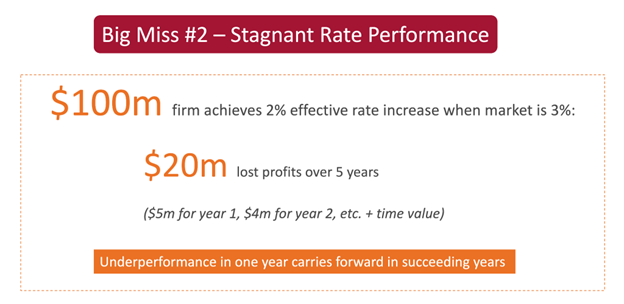Today’s blog is part two of a three-part series on Big Pricing Misses[1].
Last week, I described the current precarious law firm rate-setting environment that attempts to find value balanced with talent inflation, demand uncertainty, and the current rate cycle.
I then introduced the three big pricing misses, starting with Big Miss #1 – Unnecessary Discounting. In that post, I described the 3x rule, which represents a discount’s magnified impact on profits.
This week we will focus on:
Big Miss #2: The Perils of Rate Stagnation (Flat Rates)
Rate stagnation (e.g., flat rates) is a prolonged period of constant rates, usually over multiple years. For example, it occurs in situations like those described below.
- Where Pricing is Not a Focus. Stagnation is a natural phenomenon of operating any business absent a pricing strategy. For legal services, business-generating lawyers might initiate an engagement, do a great job on the matter, and then ignore pricing strategy. Consequently, rates stay constant, absent a stimulus for change, resulting in flat rates.
- Where Partners Have Too Much Rate Setting Freedom. Rate stagnation can also result from laissez-faire rate-setting processes, which allow lawyers to set their own rates. It is human nature to undervalue one’s services, and lawyers are often not focused on or comfortable discussing pricing with clients.
- With Tough Price-Sensitive Clients. Sometimes there are very price-sensitive clients with excellent negotiating skills. These clients (commonly large institutional clients) may press firms hard to keep rates constant over long periods or require rate reversion to prior year levels. In these cases, clients are betting that firms will be glad to retain the work rather than pressing for a pricing discussion. The result is stagnation.
- With Price-Sensitive Services. Some services (e.g., insurance defense, employment law) are economically price-pressured. Price-pressured situations are somewhat of an extreme version of the Tough Client category above. It results in the firm having to decide whether they want to deal with the lower rates and change how they practice. But more often, firms settle for flat rates rather than migrating a practice.
The consequences of flat rates are significant and cost firms tens of millions of dollars over time.
Rate Stagnation Quantified
Flat rates will hurt you materially for a long time. And rate stagnation falls into a class of easily understood problems that can be hard to avoid (like fitness and the challenge of regular exercise).
For example, if you are a $100 million firm and you lag the market by 1% over five years, you nominally have cost your firm $15 million. And when you factor time-value, you get closer to $20 million (see illustration below):

Most leaders understand the math above but cannot avoid or quickly remedy the situation. Below I offer ideas to directly address it.
Reducing Rate Stagnation
- Break Inertia. The most important thing to do is to develop a tracking system that spots flat rates and addresses those situations. The mechanics are straightforward in most cases. But flat rates are hard to fix. So, it is critical to identify stagnation points and resolve them rather than letting them sit idle, creating bigger problems.
- Be Persistent … but Patient. You can rarely recover pricing gaps in a single step but getting on the road to a better place is imperative. If you don’t, your losses mount and your client perception may wane. Savvy clients will take advantage of passive rate strategies and box you in. Commit to difficult but productive discussions with partners and clients to advance rates to an improved position.
- Make It a Priority … On Everyone’s Radar. One of the best remedies for flat rates is avoiding the situation at the outset. And the best way to do this is to educate and hold your partners accountable for rate performance. While the math above is reasonably straightforward, lawyers don’t always appreciate the financial harm until it is too late. Therefore, educating lawyers, tracking and holding partners accountable, and creating early warning systems are your best bet for reducing rate stagnation from the outset.
Next week – in the last installment of this series – I will discuss rate dispersion and my pricing forecast for fiscal 2023.
[1] The three big misses are: Unnecessary Discounting, Flat Rates, and Wide Rate Dispersion.
Posted In

